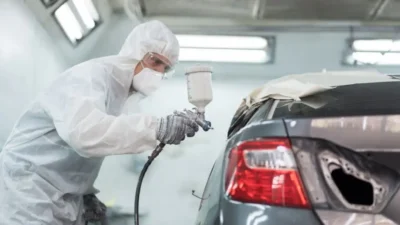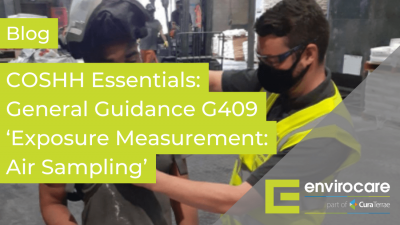Occupational Hygiene

Workplace Exposure Limits (WEL): COSHH Regulations Explained
/Our experts explain what workplace exposure limits are under the COSHH regulations.
Read more »
Whole Body Vibration at work: What you need to know
/Whole body vibration (WBV) is the term for when vibrations are transmitted through the seat or feet of a worker. For example, this could be a person who drives a mobile machine, or other work vehicle, over rough and uneven surfaces as a central part of their job.
Read more »
Isocyanate Exposure in the Workplace
/Here we answer any common questions around isocyanate exposure in the workplace – do you know your exposure limits, and how to monitor and control isocyanate exposure?
Read more »
Hand-arm Vibration – What you need to know
/Hand-arm vibration affects thousands of UK workers each year, and causes various afflictions such as carpal tunnel syndrome. These symptoms are due to vibration exposure altering the flow of blood, which then results in nerve symptoms and blood circulation damage.
Read more »
Respirable crystalline silica dust – the next asbestos
/Respirable crystalline silica is created by a range of manufacturing processes. It is a particular problem in foundry practices, where green sand is used in metal moulds.
Read more »
Envirocare welcomes bespoke technology – the iSmith
/Envirocare’s Occupational Hygiene Team is improving efficiency and working practices by embracing its new project management tool – the iSmith.
Read more »
Chris Creasey awarded prestigious qualification from the British Occupational Hygiene Society (BOHS)
/Envirocare’s Occupational Hygienist, Chris Creasey has been awarded his professional qualification by the British Occupational Hygiene Society (BOHS).
Read more »
What are Electromagnetic Fields? (EMF)
/Electric and magnetic fields occur naturally in nerves and muscles of our bodies, and in the Earth’s magnetic field. In the workplace we are concerned about Electromagnetic Fields (EMF) produced by currents and fields in electric power systems.
Read more »
ProtectHear visit Envirocare Bradford Office
/Safe practices regarding noise management are an imperative for today’s workforce; the number of workers with work-related hearing problems is estimated to be at 14000, using three years of data from the Labour Force Survey.
Read more »
COSHH Essentials: General Guidance G409 ‘Exposure Measurement: Air Sampling’
/The Health and Safety Executive issued an updated guidance document which provides practical advice on when you must measure exposure to airborne substances, how to measure exposure, the substances, demonstrating control, and what should be included in the content of a consultants’ report.
Read more »
Hexavalent Chromium/Chromium (VI) and REACH
/Hexavalent chromium is included in the REACH directive as it is a known human carcinogen. It is a SVHC (Substance of Very High Concern), and the waste produced from industrial processes involving it poses a serious threat to human health.
Read more »
COVID-19 and Increased Risk of Legionella
/During the ongoing COVID-19 pandemic, many buildings have been left with reduced occupancy or have been closed. With reduced usage and interruption of cleaning regimes, water system stagnation is likely to occur. Stagnation offers an ideal breeding ground for legionella bacteria, increasing the likelihood of people contracting Legionnaire’s disease. What is Legionnaires disease? Legionella is […]
Read more »
Benefits of Improving Employee Safety
/Employee safety should never be overlooked or be considered any less important than profit or reputation. In fact, employee safety can help develop a higher profit and an improved reputation. By creating a safe environment for employees to work in, companies are also protecting themselves. Safety Leads to Productivity Employees that feel safe and comfortable […]
Read more »
Enforcement Expectations for Mild Steel Welding Fume Grow Higher
/The HSE Update In February 2019, the HSE released their latest bulletin, STSU1, which details the change in enforcement expectations for all welding fume including mild steel welding fume. The bulletin comes on the back of International Agency for Research on Cancer’s (IARC) reclassification of all welding fume including mild steel as Group 1 carcinogenic […]
Read more »
Noise Assessments | How Often Should A Noise Survey Be Carried Out?
/We’ve already established a company’s obligation in terms of Noise Regulations but a question we get asked over and over again is “How often should noise assessments and noise surveys be carried out?” Unfortunately, there is no clear cut answer listed in regulation. In the Control of Noise at Work Regulations, they state that a noise risk assessment […]
Read more »
Workplace Exposure Monitoring & COSHH Air Sampling
/The fifth step in the COSHH workplace exposure monitoring process happens once you have ensured all control measures are in place, and procedures have been put in to ensure that controls are used and maintained. We now need to see how effective these controls are. This can be done in two ways, the first of […]
Read more »
Noise Exposure Limits | Everything You Need To Know
/Employers Basic Requirements For Noise Exposure Limits UK Noise Regulations (The Control of Noise at Work Regulations of 2005) states three stages of control regarding noise exposure limits in the workplace. These relate to the levels of exposure to noise of employees average over a specific working day or week and also the maximum noise to which […]
Read more »
COSHH Testing | Ensuring Exposure Controls are Used and Maintained
/The fourth step in the COSHH testing and COSHH risk assessment process is to ensure that all exposure controls installed are used and maintained. So You Have The Kit, Make Sure You Use It From over 20 years of experience in the field, we know that making sure the above statement is put into practice can […]
Read more »
COSHH Assessments | How To Control Exposure
/The third step in completing your COSHH Assessments is the point at which you ask “we have the data, but what can we do to reduce and control exposure?” For this, we go back to the COSHH hierarchy of control: Elimination This is the gold standard for how to control exposure, but it is one […]
Read more »
Noise Regulations: What Are Your Obligations?
/A Brief Guide To UK Noise Regulations Noise Regulations act as a safety net due to noise being a common issue in most industrial environments we carry out work in, whether it be the hum of a production line in a printing works or the short, sharp noise of a hammer hitting a metal unit […]
Read more »
COSHH Precautions In The Workplace
/The second step of the COSHH Risk Assessment process is to decide what COSHH precautions are required. For this, we look at the five W’s and an H: What? What does the process involve? What materials are involved? Does the work involve working in the breathing zone, and are the materials listed as hazardous on […]
Read more »
Removing Earwax And Tips For Clearing Blocked Ears
/Envirocare provide Workplace Hearing Tests and occupational ear examinations to companies within the UK. This article aims to help people in removing earwax or clearing blockages caused by wax. We regularly provide the below advice to anyone we encounter whose ear drums or ear canals appear to show a large build up of earwax. Here are some of the things […]
Read more »
COSHH Risk Assessment – Assessing The Risks
/What Is A COSHH Risk Assessment? A COSHH (Control of Substances Hazardous to Health) risk assessment will identify substances and activities where there may be exposure to hazardous substances, used or generated, which may damage health. It’s about taking sensible steps to prevent ill health to employees and visitors. The aim of an assessment is to know […]
Read more »
What Is COSHH? Everything You Need To Know
/We’re often asked the question ‘What is COSHH?’. So we’ve decided to create an article which aims to define COSHH in simple terms. We have supplied supporting information so that you have everything you need to know in order to run your operations safely, efficiently and profitably. So, What Is COSHH? The term COSHH stands for ‘Control of […]
Read more »